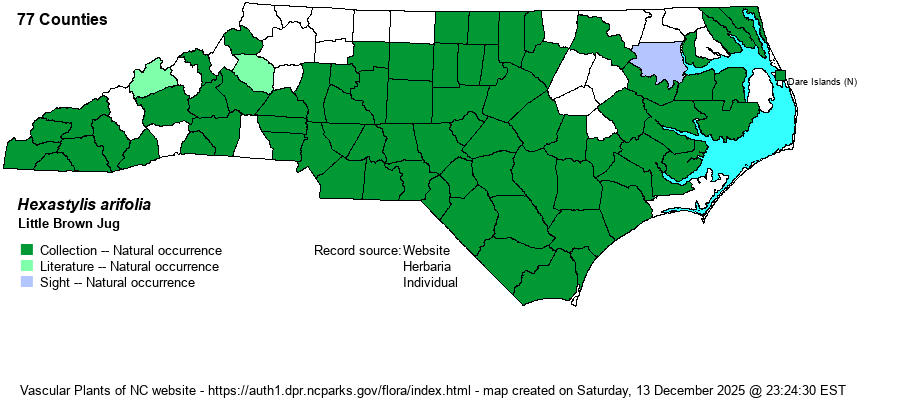| Author | (Michaux) Small | |
| Distribution | Nearly statewide, but likely absent in the extreme northwestern counties of the Piedmont and Mountains. Also, scarce in the northern Coastal Plain, legitimately absent in a few counties there. More widespread in the central and southern parts of the state.
This is a Southeastern species, barely ranging north to southern VA and southeastern KY, then south to northwestern FL and southeastern LA. | |
| Abundance | Common and widespread in nearly all of the central and southern parts of the Coastal Plain and Piedmont, including the Triangle area; fairly common to common in the southern half of the Mountains. Rare to uncommon in the northwestern part of the state and also in the northern counties of the Coastal Plain. | |
| Habitat | This is a species of a great variety of upland forests, ranging from hardwood forests to mixed forests, and occasionally into pine stands. It favors acidic soils, and can be found in quite dry sites. It can grow in the drier portions of bottomland forests and other wetland edges. |
| Phenology | Blooms mainly from March to May, and fruits shortly after flowering. | |
| Identification | This very familiar species should be easily identified by most biologists. It has several arrowhead-shaped, evergreen leaves growing from a ground base, each leaf on a stalk about 2 inches long, with a triangular blade about 4-5 inches long and about 3-4 inches wide, with a rounded tip and strongly sagittate bases. The leaves are thick, shiny, and dark green, but with very distinctive pale green blotches between the veins on the top side. No other Hexasttylis species in NC has pale green blotches between the veins; others have blotches along the veins themselves. The flowers are also quite different from the others; the several flowers grow at the base of the plant, partly hidden by fallen leaves, such that you may have to brush away old leaves to see them. Each flower (calyx, as there are no petals) is a long and narrow "jug", about 1 inch long and half as wide, with a rounded base and three very short lobes. They are tan to pale brown in color. Other Hexastylis species have much wider (i.e., more open) calyx tubes such that the shape is more of a cup than a jug or vase. All Hexastylis species are more easily seen on a forest walk in winter or the cooler months, when they are often among the few evergreen species visible on the forest floor. | |
| Taxonomic Comments | This species was formerly split into two varieties -- var. arifolia and var. ruthii. Recent authors have split out ruthii as a full species, and Weakley (2018) states: "Perhaps warranting species status" for var. ruthii, as well.
| |
| Other Common Name(s) | Arrowleaf Heartleaf, Arrowhead Heartleaf, Heartleaf Ginger. Though the use of "Little Brown Jug" is an idiosyncratic name, instead of using the general group name of "heartleaf", this species has distinctly different leaves and especially flowers from the rest, and as most references do use "Little Brown Jug" as a common name, it seems best not to force its preferred name for the website into a "heartleaf". | |
| State Rank | S5 | |
| Global Rank | G5 | |
| State Status | | |
| US Status | | |
| USACE-agcp | FAC link |
| USACE-emp | FAC link |

